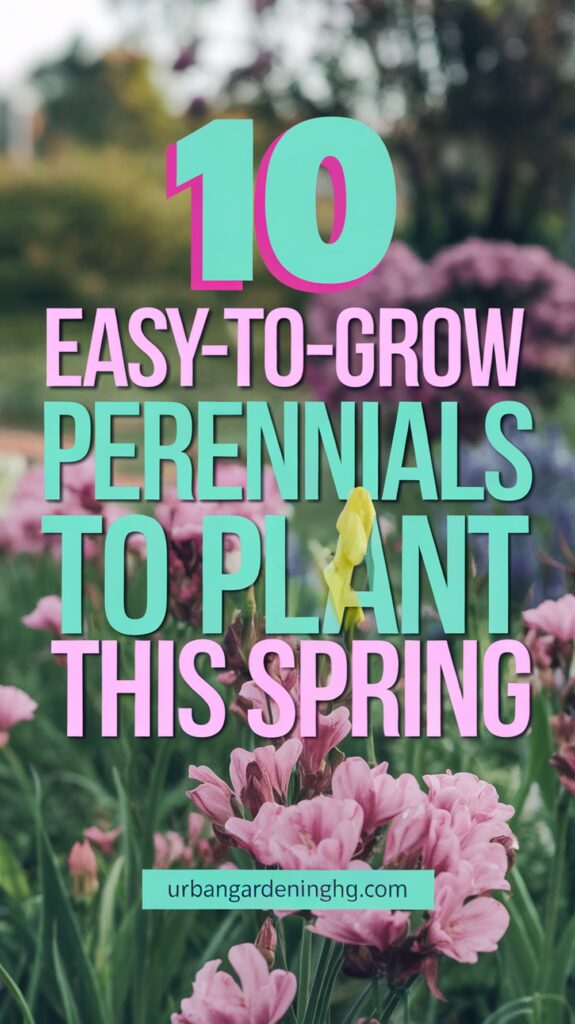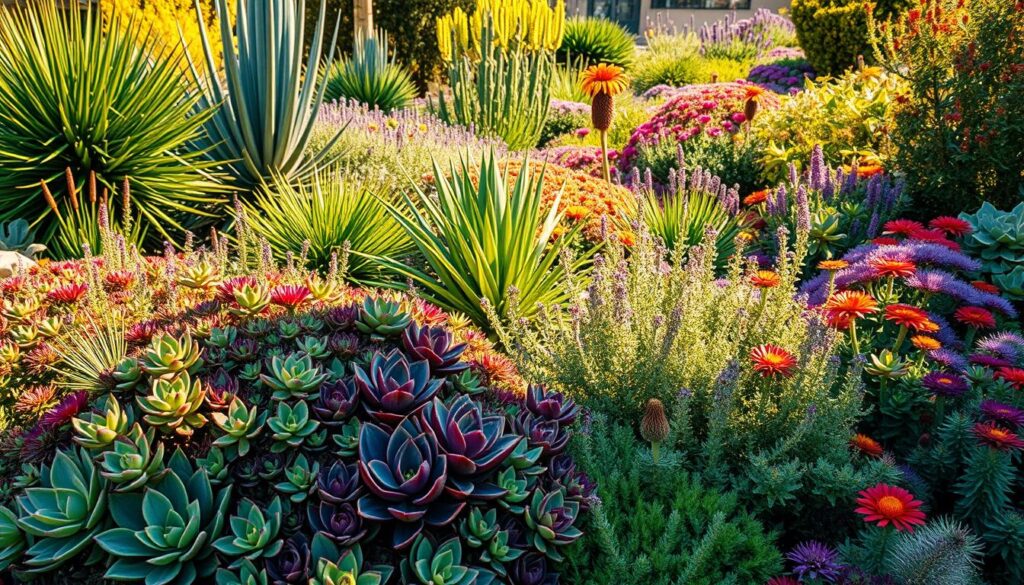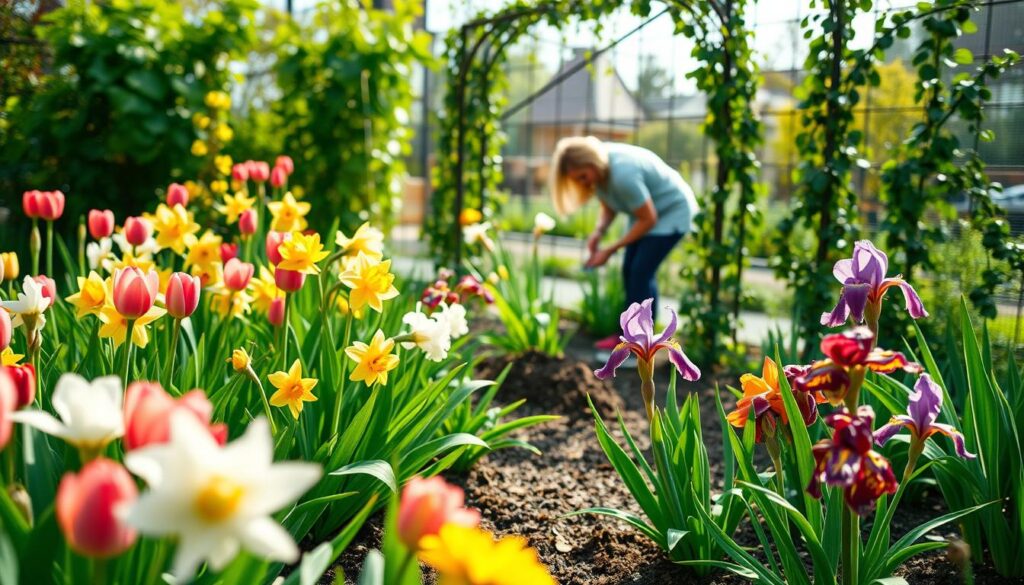I’m excited to share my favorite low-maintenance perennials for this spring. They will add beauty to your garden for years. Perennials are easy to care for and grow well in different conditions. Black-Eyed Susan, Coreopsis, and Sedum are great for adding color.
I choose perennials that are beautiful and easy to care for. Helenium and Asters are perfect for full sun and attract pollinators. By picking the right perennials, you can create a stunning garden that attracts pollinators and beautifies your outdoor space.
Some top picks include Coneflowers and Daylilies. Coneflowers grow 12 to 36 inches tall and love full sun. Daylilies grow well in various soils and are deer-friendly. Adding these to your garden will make it beautiful and thriving, bringing joy for years.
Why Perennials Are the Smart Choice for Your Garden

As a gardener, I’ve learned the value of perennials. They are a smart choice for gardens because they save money. You can divide and replant them, cutting down on the need for new plants. This method not only saves cash but also helps create a lively garden ecosystem.
Perennials are also easy to care for. They don’t need to be replanted every year, saving you time and effort. This makes them perfect for those with busy schedules or who want a garden with little upkeep. By choosing low-maintenance perennials, you can have a stunning garden with minimal care.
Perennials offer many benefits. They add interest to your garden all year, attract pollinators, and use less water. By picking the right perennials, you can make your garden sustainable and eco-friendly. They can thrive in different conditions, making them a smart and affordable choice for gardening.
Using perennials in your garden design is a smart move. It saves time and money while providing a beautiful space. This approach also helps attract pollinators, saves water, and keeps your garden interesting all year.
Understanding Your Garden’s Growing Conditions
To make your perennial garden bloom, you need to know your yard’s growing conditions. This means looking at soil types, climate, and sunlight. By understanding these, you can pick the best plants for your garden, making it grow and bloom well.
Soil types are key to a successful garden. Plants like different soils, so testing yours is important. Climate, like temperature and rain, also affects plants. Knowing your local climate helps choose the right perennials for your area.
When checking your garden’s conditions, think about these:
- Soil drainage and composition
- Climate and hardiness zone
- Sunlight and shade patterns
By considering these, you can make a garden that thrives and looks great for years. Choose plants that fit your soil and climate for a garden that’s easy to care for.
Essential Tools and Supplies for Planting Perennials
When I start planting perennials, I make sure I have the right tools and supplies. These help my garden grow well with little care. The right tools let me enjoy my perennials without worrying about their health.
I always have a trowel, hori hori knife, dibber, and garden fork ready. These tools make planting and digging easier. I also use compost or fertilizer to feed my plants. Mulch like wood chips or straw keeps the soil moist and weeds away.
Choosing the right tools and supplies is important to me. I look for durability, sustainability, and ease of use. Tools made from high-carbon boron steel and European ash are effective and eco-friendly. With the right tools, my perennial garden will be beautiful and thriving for years.
Some popular garden tools and supplies include:
- Trowels for digging and transplanting
- Hori hori knives for cutting through roots and taproots
- Dibbers for even seed and bulb spacing
- Garden forks for breaking up soil and aerating garden beds
- Soil amendments like compost or fertilizer
- Mulching materials like wood chips or straw
Best Perennials to Plant This Spring for Sunny Gardens
For sunny gardens, many perennials do well in full sun and need little care. I look for plants that can handle drought and look great. Black-Eyed Susan, Coneflower, and Lavender are top picks for sunny spots.
These plants are not just beautiful but also draw in pollinators. They bring vibrant colors to your garden. Goodhousekeeping.com says Black-Eyed Susan blooms all spring and fall. It’s perfect for sunny gardens, being hardy in zones 3-11.
Benefits of Low-Maintenance Perennials
- Require less watering and care
- Can thrive in poor soil conditions
- Attract pollinators and add beauty to the garden
Choosing the right perennials for sunny gardens makes for a stunning, easy-care space. With the right care, these plants will bring joy for years.
Shade-Loving Perennials for Spring Planting
There are many shade-loving perennials to choose from. These plants do well in partial to full shade. They also grow in different soil types. Hostas and Astilbe are favorites for their beautiful leaves and bright flowers.
For easy care, try Hellebore or Bleeding Heart. They add color to your shade garden with little effort. Brunnera, Foamflower, and Lungwort also offer a variety of colors and textures.
Shade-loving perennials are great for areas with little sunlight. They also need less care. They can grow in poor soil. Here are some popular ones:
- Hostas: known for their large, leafy foliage and vibrant flowers
- Astilbe: features feathery plumes in a range of colors, including pink, white, and red
- Hellebore: blooms in late winter to early spring with nodding, bell-shaped flowers
- Bleeding Heart: produces heart-shaped flowers in a range of colors, including pink and white
Adding these perennials to your garden brings beauty and texture to shaded areas. They are easy to care for and grow in many soils. They’re perfect for any gardener.
| Perennial | Bloom Time | Height |
|---|---|---|
| Hosta | Summer | 2-5 feet |
| Astilbe | Summer | 2-4 feet |
| Hellebore | Winter-Spring | 1-2 feet |
| Bleeding Heart | Spring-Summer | 2-3 feet |
Drought-Resistant Perennial Options
As a gardener, I’m always searching for plants that can handle tough conditions. Drought-resistant perennials are perfect for saving water. Favorites like Sedum, Russian Sage, and Yarrow are not only stunning but also survive dry spells well.
These plants also draw in pollinators. Sedum and Yarrow, for instance, attract bees and butterflies. This helps other plants in your garden get pollinated. Plus, they grow well in many soils, even poor ones.
Sedum
Sedum is ideal for gardens that don’t get much rain. It stores water in its leaves, lasting long without water. It’s also very easy to care for.
Russian Sage
Russian Sage is another top pick for dry gardens. It handles dry spells and poor soil well. Its silvery-gray leaves also make gardens look beautiful.
Yarrow
Yarrow is versatile and can handle different conditions. It’s good with both dry and wet weather. Its fern-like leaves and white or yellow flowers add beauty to any garden.

Adding drought-resistant perennials to your garden makes it beautiful and water-friendly. They need little care and attract pollinators. These plants are a smart choice for any gardener.
Creating Color Throughout the Seasons
As a gardener, I’ve learned that a key to a beautiful garden is color all year. By choosing plants that bloom at different times, your garden stays interesting. This makes your garden a low-maintenance, cost-effective beauty.
Plant a mix of perennials for each season. Spring brings tulips and daffodils. Summer flowers like black-eyed Susans and coneflowers follow. Then, asters and chrysanthemums bloom in fall. Snowdrops and winter aconites add color in winter.
For a colorful garden, deadhead plants and divide perennials in spring. Mulch helps keep moisture in and weeds out. These steps help your garden thrive with little care. With the right design and plants, your garden will be a colorful delight all year.
Companion Planting Strategies for Perennials
When planning my garden, I think about companion planting. Pairing perennials with other plants makes my garden healthy and thriving. This approach boosts garden resilience and productivity, reducing pests and increasing yields.
Studies show that mixing crops can lower pest encounters. For example, radishes with pumpkins repel squash bugs. Basil helps keep tomato pests away. These tips help me design a balanced garden.

Best Plant Combinations
Some perennial pairings work well together. Dwarf sunflowers around corn fields attract ladybugs, controlling pests. Pollinator strips, rows of beneficial plants, draw in pollinators and pest predators.
- Garlic repels aphids, onion flies, ermine moths, and Japanese beetles, reducing pest vulnerability.
- Legumes like beans and peas improve soil nitrogen, benefiting other plants.
- Tansy attracts beneficial insects while keeping pests like cutworms away.
Spacing Guidelines
For effective companion planting, I must follow spacing guidelines. Tall plants like sunflowers and corn shade leaf crops, preventing them from bolting. I can also plant baby lettuce or spinach between garlic to use space well.
Common Mistakes to Avoid When Planting Perennials
When planting perennials, it’s key to avoid common mistakes. One big mistake is not preparing the soil well. This can cause poor drainage, lack of nutrients, and more problems with pests and diseases.
Another mistake is not watering enough. Perennials need steady moisture, but too much water can harm them. To avoid these issues, pick perennials that fit your climate and soil.
Some common mistakes to avoid when planting perennials include:
- Inadequate soil preparation
- Insufficient watering
- Planting at the wrong time
- Not providing enough space for growth
- Not mulching or fertilizing properly
To make sure your perennials do well, avoid these mistakes. Choose easy-to-care-for perennials, prepare the soil right, and keep the moisture steady. With some planning and care, you can have a beautiful perennial garden.
| Perennial | Soil Requirements | Watering Needs |
|---|---|---|
| Black-Eyed Susan | Well-draining soil | Consistent moisture |
| Coneflower | Fertile soil | Regular watering |
| Lavender | Dry to medium soil | Infrequent watering |
Essential Care Tips for Long-Lasting Blooms
To keep your perennials healthy and blooming, follow some key care tips. Good care can greatly improve your garden’s look and health. With these tips, you can enjoy vibrant, easy-to-care-for perennials that bloom for years.
Watering is a big part of caring for perennials. Once or twice a week is usually enough, depending on the weather and soil. Also, add several inches of compost to the soil to help with drainage and water holding. You can find more info on long-lasting blooms and how to get them in your garden.
Some important strategies for caring for perennials include:
- Mulching with an inch or two of organic material to keep moisture in and weeds out
- Regularly removing weeds to stop them from competing for water and nutrients
- Pruning to help plants stand up straight and avoid needing stakes

By using these tips and picking varieties that resist disease and drought, like phlox and monarda, you can have a stunning garden with little work. With the right care, your perennials will bloom for a long time and stay healthy. They’re perfect for those who want low-maintenance plants.
Dividing and Propagating Your Perennials
Dividing and propagating perennials is key to a healthy garden. This process, or perennial division, splits established plants into smaller ones. You can use division, layering, or cuttings for propagation.
Timing is critical when dividing perennials. The best time depends on the plant type. For example, ornamental grasses do well in spring, while astilbes and peonies are better in fall. Avoid dividing in the hot summer. Early spring and fall are best for root growth.
To divide, dig around the plant, getting as much root as you can. Aim for 8 to 12 inches of digging space. After digging, separate the roots carefully. Divide each section to about a quarter of the original size. Plant them 10 to 12 inches apart for growth.
Some plants need tools for division, while others can be done by hand. Not all plants can be divided. Spread the roots wide and down when replanting. This helps the plant grow strong. By following these steps, you can grow a beautiful garden with low-maintenance perennials.
Your perennials will grow and thrive with care. Protect new plants from too much sun to prevent water loss. Keep the soil moist in the first year. Learning to divide and propagate perennials will let you enjoy your garden for many years.
Winter Protection for Your Perennial Garden
As winter comes, it’s key to protect your perennial garden. This is vital for low-maintenance perennials to survive harsh weather. Mulching is a good way to do this by covering the soil with organic material.
Experts say a 2-4 inch layer of mulch is enough. It keeps the soil warm and stops moisture from escaping. Mulch also keeps weeds away and cuts down on watering.
Some perennials need extra care in winter. Potted plants might need to go inside or be covered with burlap. This protects them from freezing.
By following these tips, your perennial garden can stay healthy and beautiful all year. Choose plants that fit your climate and give them the care they need.
Troubleshooting Common Perennial Problems
As a gardener, you might face issues like pests, diseases, and nutrient shortages. It’s key to solve these problems by watching your garden closely. Regular checks can stop problems before they start. For example, spotting pests or diseases early means you can act fast, avoiding big treatments later.
Common issues include powdery mildew, botrytis blight, slugs, aphids, and mites. To fix these, try organic and integrated pest management. Neem oil can fight pests, and removing sick plants stops disease spread. Choosing easy-to-care-for perennials and following care tips can help avoid these problems. This way, you can enjoy a healthy garden.
For more gardening tips and troubleshooting, check out spring garden ideas. These tips can help you make your garden beautiful and sustainable. With these ideas, your garden will be a source of joy for years.
Here are some more tips for dealing with perennial problems:
- Deadheading can extend the bloom season for many perennials
- Staking is necessary for tall perennials to protect flower spikes from wind and rain
- Fertilizing should be done in spring with products like Plant-O-Ganic or Osmocote
Conclusion: Creating Your Perennial Paradise
Starting your perennial garden is a journey filled with joy. The right low-maintenance perennials and creativity can turn your yard into a paradise. This article’s tips will help you create a beautiful, sustainable garden that shows off your style and love for nature.
To make your garden thrive, know your growing conditions and choose the right plants. Give them the care they need. With patience and dedication, your garden will bring you joy and peace every season.
So, why wait? Dive into the beauty of perennials and start your own paradise today!


